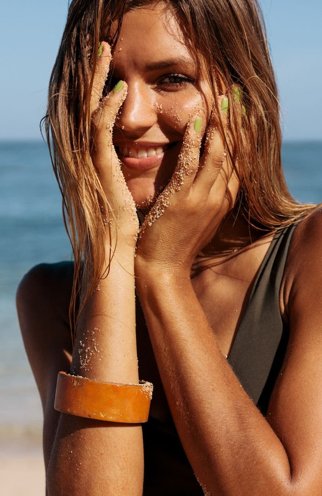Mattifying Sunscreen: Keep Shine & Sun Damage At Bay

Summer has finally come knocking, and it’s almost time to soak up the sun. But before you head out, it’s important to make sure your skin is protected from harmful UV rays with the help of a mattifying sunscreen. If you’ve got oily skin, you’ll know just how hard it is to find face products that leave you shine-free – but a

What is a mattifying sunscreen?
Mattifying sunscreen is a type of sunscreen that is designed to keep your skin looking matte and shine-free. It contains ingredients that help to absorb excess oil and prevent your skin from looking greasy, so is perfect for those with oily skin who want to keep their complexion looking fresh and shine-free.
Why use a mattifying sunscreen?
There are several benefits to using a matt SPF. First and foremost, it helps to protect your skin from harmful UV rays, which can cause sunburn, premature ageing, and even skin cancer. However, Syed claims that there are some other factors to consider when choosing the best mattifying sunscreen for you.
“If you simply prefer a non-shiny finish to your skin, then a mattifying sunscreen is a good choice,” she says. “But if you want to control oily skin or prevent breakouts, you’ll need to be more particular with your SPF choice. Opt for a non-comedogenic formula, which won’t clog your pores — and choose a formulation that’s oil-free and oxybenzone-free.”
How to use a mattifying sunscreen
When it comes to SPF application, Syed says that there are a few golden rules to follow. “It actually depends on the type of sunscreen you’re using and whether it’s chemical or physical (mineral),” she says. “If you use chemical sunscreen, you should apply it before
“If the moisturiser is applied before the chemical sunscreen, it could actually change the properties of your sunscreen and create a barrier between your skin and the SPF meant to protect it.
“Physical (mineral) sunscreen should go on after moisturiser, as it needs to sit on top of your skin so the actives will act like a shield against the UV rays.”
The best oil-free sunscreen for face
Clarins UV PLUS [5P] Anti-Pollution Translucent is a high-tech, high-performance facial sunscreen that protects the skin from UVA and UVB radiation, environmental aggressors and blue light. It also has a lightweight, creamy texture that dissolves instantly into the skin. Powered by organic mango leaf extract, it enhances skin's self-defense by 64%, hydrates and cares for your skin.
Clarins Youth-protecting Sunscreen Very High Protection SPF50+ has a combination of sun filters offers broad spectrum protection against UVA/UVB rays and prevents the appearance of dark spots. Organic cocoa extract helps to boost skin hydration and provides firming benefits for an anti-wrinkle action. Vitamin E derivative with antioxidant properties helps protect skin from the effects of free radicals. This hydrating SPF50+ face cream has a smooth, melting texture that leaves a dry-touch matte finish.
If you want to find the matt sunscreen that is easily used to re-apply, this Invisible Sun Care Stick is the one. It has an ultra-comfortable "bare skin" texture that stays invisible as it protects the most sensitive parts of your face, from eye area, cheeks, ears and nose.
Mattifying sunscreen FAQs
Can I skip moisturiser and use matt sunscreen for oily skin?
According to most skincare professionals, replacing your moisturiser with a sunscreen (and vice versa) is a total no-go. “I would never recommend doing this, as the functions of the two products are very different,” Syed explains. “A moisturiser helps to keep your skin hydrated, while nourishing the skin to help keep your skin healthy. A sunscreen’s primary function is to protect against harmful UV rays.”
Put simply? You can’t skimp on either of these important steps in your routine.
Why does my sunscreen make my face so oily?
Some sunscreens can make your face feel oily after you put them on, and this is usually because they contain oil to help protect your skin from the sun. If your sunscreen makes your face feel oily, try using a sunscreen that is labelled ‘non-comedogenic’, which means that it is less likely to cause blackheads or other acne.
“Oily skin is due to the sebaceous glands in the skin producing more sebum than usual,” Syed adds. “While every skin type needs sunscreen, it is important to ensure that you choose a sunscreen product that won’t add more oil to your skin, leading to breakouts.
“There are two reasons why sunscreen can make your face oily. First, any type of sunscreen that has a heavy formulation can block the pores and cause breakouts. Second, chemical sunscreens can worsen breakouts by inflaming the skin further. This is because the active ingredients are built to react with UV rays and turn into infrared radiation, which then try to disperse as heat.”
Can sunscreen cause acne breakouts?
“If you have oily skin and want to avoid breakouts occurring, it’s best to use an oil-free sunscreen for face that won’t clog your pores,” Syed recommends. “Choose lightweight formulas specifically made for oily and acne-prone skin. Opt for a non-comedogenic formula as it won’t clog your pores — and remember to choose a formulation that’s oil-free and oxybenzone-free.”
